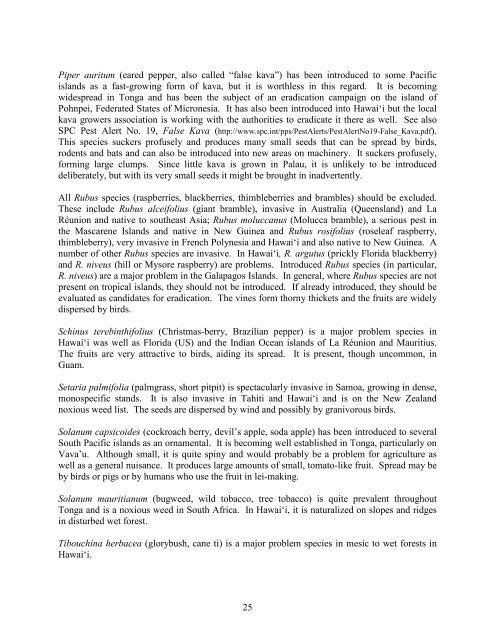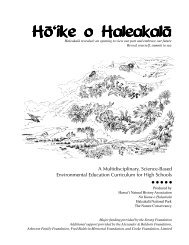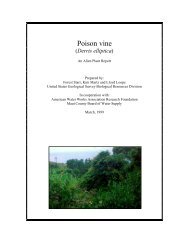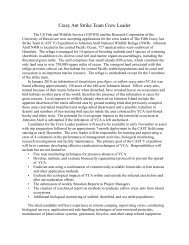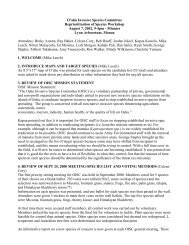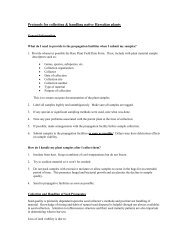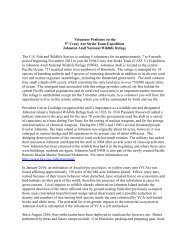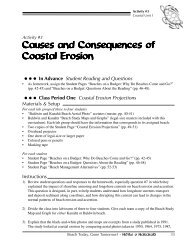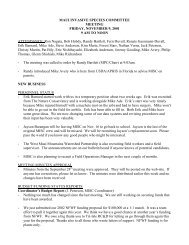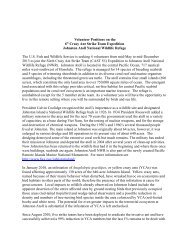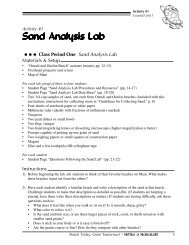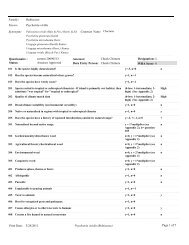Report to the Republic of Palau: 2008 update on Invasive Plant ...
Report to the Republic of Palau: 2008 update on Invasive Plant ...
Report to the Republic of Palau: 2008 update on Invasive Plant ...
You also want an ePaper? Increase the reach of your titles
YUMPU automatically turns print PDFs into web optimized ePapers that Google loves.
Piper auritum (eared pepper, also called “false kava”) has been introduced <str<strong>on</strong>g>to</str<strong>on</strong>g> some Pacific<br />
islands as a fast-growing form <str<strong>on</strong>g>of</str<strong>on</strong>g> kava, but it is worthless in this regard. It is becoming<br />
widespread in T<strong>on</strong>ga and has been <str<strong>on</strong>g>the</str<strong>on</strong>g> subject <str<strong>on</strong>g>of</str<strong>on</strong>g> an eradicati<strong>on</strong> campaign <strong>on</strong> <str<strong>on</strong>g>the</str<strong>on</strong>g> island <str<strong>on</strong>g>of</str<strong>on</strong>g><br />
Pohnpei, Federated States <str<strong>on</strong>g>of</str<strong>on</strong>g> Micr<strong>on</strong>esia. It has also been introduced in<str<strong>on</strong>g>to</str<strong>on</strong>g> Hawai‘i but <str<strong>on</strong>g>the</str<strong>on</strong>g> local<br />
kava growers associati<strong>on</strong> is working with <str<strong>on</strong>g>the</str<strong>on</strong>g> authorities <str<strong>on</strong>g>to</str<strong>on</strong>g> eradicate it <str<strong>on</strong>g>the</str<strong>on</strong>g>re as well. See also<br />
SPC Pest Alert No. 19, False Kava (http://www.spc.int/pps/PestAlerts/PestAlertNo19-False_Kava.pdf).<br />
This species suckers pr<str<strong>on</strong>g>of</str<strong>on</strong>g>usely and produces many small seeds that can be spread by birds,<br />
rodents and bats and can also be introduced in<str<strong>on</strong>g>to</str<strong>on</strong>g> new areas <strong>on</strong> machinery. It suckers pr<str<strong>on</strong>g>of</str<strong>on</strong>g>usely,<br />
forming large clumps. Since little kava is grown in <str<strong>on</strong>g>Palau</str<strong>on</strong>g>, it is unlikely <str<strong>on</strong>g>to</str<strong>on</strong>g> be introduced<br />
deliberately, but with its very small seeds it might be brought in inadvertently.<br />
All Rubus species (raspberries, blackberries, thimbleberries and brambles) should be excluded.<br />
These include Rubus alceifolius (giant bramble), invasive in Australia (Queensland) and La<br />
Réuni<strong>on</strong> and native <str<strong>on</strong>g>to</str<strong>on</strong>g> sou<str<strong>on</strong>g>the</str<strong>on</strong>g>ast Asia; Rubus moluccanus (Molucca bramble), a serious pest in<br />
<str<strong>on</strong>g>the</str<strong>on</strong>g> Mascarene Islands and native in New Guinea and Rubus rosifolius (roseleaf raspberry,<br />
thimbleberry), very invasive in French Polynesia and Hawai‘i and also native <str<strong>on</strong>g>to</str<strong>on</strong>g> New Guinea. A<br />
number <str<strong>on</strong>g>of</str<strong>on</strong>g> o<str<strong>on</strong>g>the</str<strong>on</strong>g>r Rubus species are invasive. In Hawai‘i, R. argutus (prickly Florida blackberry)<br />
and R. niveus (hill or Mysore raspberry) are problems. Introduced Rubus species (in particular,<br />
R. niveus) are a major problem in <str<strong>on</strong>g>the</str<strong>on</strong>g> Galapagos Islands. In general, where Rubus species are not<br />
present <strong>on</strong> tropical islands, <str<strong>on</strong>g>the</str<strong>on</strong>g>y should not be introduced. If already introduced, <str<strong>on</strong>g>the</str<strong>on</strong>g>y should be<br />
evaluated as candidates for eradicati<strong>on</strong>. The vines form thorny thickets and <str<strong>on</strong>g>the</str<strong>on</strong>g> fruits are widely<br />
dispersed by birds.<br />
Schinus terebinthifolius (Christmas-berry, Brazilian pepper) is a major problem species in<br />
Hawai‘i was well as Florida (US) and <str<strong>on</strong>g>the</str<strong>on</strong>g> Indian Ocean islands <str<strong>on</strong>g>of</str<strong>on</strong>g> La Réuni<strong>on</strong> and Mauritius.<br />
The fruits are very attractive <str<strong>on</strong>g>to</str<strong>on</strong>g> birds, aiding its spread. It is present, though uncomm<strong>on</strong>, in<br />
Guam.<br />
Setaria palmifolia (palmgrass, short pitpit) is spectacularly invasive in Samoa, growing in dense,<br />
m<strong>on</strong>ospecific stands. It is also invasive in Tahiti and Hawai‘i and is <strong>on</strong> <str<strong>on</strong>g>the</str<strong>on</strong>g> New Zealand<br />
noxious weed list. The seeds are dispersed by wind and possibly by granivorous birds.<br />
Solanum capsicoides (cockroach berry, devil’s apple, soda apple) has been introduced <str<strong>on</strong>g>to</str<strong>on</strong>g> several<br />
South Pacific islands as an ornamental. It is becoming well established in T<strong>on</strong>ga, particularly <strong>on</strong><br />
Vava’u. Although small, it is quite spiny and would probably be a problem for agriculture as<br />
well as a general nuisance. It produces large amounts <str<strong>on</strong>g>of</str<strong>on</strong>g> small, <str<strong>on</strong>g>to</str<strong>on</strong>g>ma<str<strong>on</strong>g>to</str<strong>on</strong>g>-like fruit. Spread may be<br />
by birds or pigs or by humans who use <str<strong>on</strong>g>the</str<strong>on</strong>g> fruit in lei-making.<br />
Solanum mauritianum (bugweed, wild <str<strong>on</strong>g>to</str<strong>on</strong>g>bacco, tree <str<strong>on</strong>g>to</str<strong>on</strong>g>bacco) is quite prevalent throughout<br />
T<strong>on</strong>ga and is a noxious weed in South Africa. In Hawai‘i, it is naturalized <strong>on</strong> slopes and ridges<br />
in disturbed wet forest.<br />
Tibouchina herbacea (glorybush, cane ti) is a major problem species in mesic <str<strong>on</strong>g>to</str<strong>on</strong>g> wet forests in<br />
Hawai‘i.<br />
25


